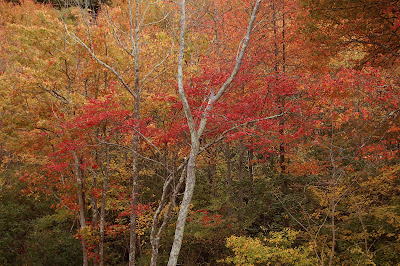Recently, pastel artist
Deborah Secor suggested a painting challenge in the WC pastel forum, inspired by artist
Marla Baggetta. Ms. Baggetta did a series of 100 paintings of the same scene that was a featured article in the most recent issue of The Pastel Journal. The idea sounded great; it's been 10 years since I've worked in pastel, and I found myself unsure about what was the best way to get back into them again. After thinking about it, I realized it was ideal for me: using the same subject repeatedly would allow me to experiment with papers, endless color schemes and themes, practice and experiment with different techniques and be able to put them side by side for comparison. It is easy to see what works and what doesn't. So, I signed up.
First, I chose a reference photo to use - in this case, a crop of a photo of Hermosa Creek north of Durango, CO this summer. The photo itself was pretty unremarkable; shot in late afternoon sun, the sky was completely blown out. But, when cropped, it suddenly had more appeal. So, I went with it. To distill it into more simple shapes and values, I first posterized it. And while the original photo has been cropped of all sky, I decided to convert the upper middle part (mountains IRL) to sky. It works.
Here is the "digital notan" version:
Challenge notan/value study
I decided on a size of approx 6x8" and allotted 30 min. for each study, in order to keep them loose and not make them too "precious". I am going to do 5 per week, for basically as long as I am getting value from the challenge. I am keeping a notebook of the materials, time, and notes about each of the studies. As I state in my "about me" section, I promised to post the wins *and* the fails. We learn from our mistakes and failures.
Challenge #1 - monochromatic study in green
soft pastel on neutral grey Mi-Tientes paper, 6x8"
This went quickly and I was pleased with the end result. This shows that if you've got the correct values, the colors really don't matter so much. Completed 10/5
Challenge #2 - spring colors
soft pastel on 400-grit sandpaper. 5.5x8"
The surface is wet/dry sandpaper available at your hardware store. It has the advantage of being: 1) inexpensive; 2) readily available. I don't mind tossing it out if things don't work. The pastels lay down nicely on the surface, and it has enough tooth to hold a few layers. I didn't spend as much time choosing colors, and we've got warm and cool going on. At least I did keep the cooler ones confined to the distance.
Challenge #4 - fall colors
soft pastel on MT creme paper, smooth side. 6x8".
This is awful. I didn't take the time to choose proper values or colors that harmonize well with each other, and it shows. Plus, the pastel would not lay down well on the paper. I don't mind seeing some paper through the pastel, but it wasn't my intent in this case. I might keep it for a while as a reminder of "what not to do again" before I throw it out. The fact that I was really tired and had a headache didn't help.
I will continue to post these as I go, but may begin to select the more interesting ones as time goes on. This is a great exercise and I will undoubtedly do it again with different subjects and with oils as well.




























